Abstract
STUDY OBJECTIVES--To determine differences in incidence and case fatality of stroke in district health authorities with differing standardised mortality ratios (SMR) for stroke in residents aged under 65 years in whom death from stroke is considered 'avoidable'. DESIGN--Registration of first ever strokes in three district health authorities. Patients were assessed and followed up over one year by one of three observers. SETTING--West Lambeth, Lewisham and North Southwark, and Tunbridge Wells District Health Authorities in south east England. PARTICIPANTS--Patients under the age of 75 years having a first ever in a lifetime stroke between 15 August 1989 and 14 August 1990. MEASUREMENTS AND MAIN RESULTS--Age specific incidence rates and survival time from stroke to death. Severity was assessed in terms of the level of consciousness and the presence of speech, urinary, and motor impairment within the first 24 hours of the stroke. Altogether 386 strokes were registered. There was a significant difference in the incidence rate between district health authorities in those aged under 65 (p < 0.01). The overall case fatality was 26% at three weeks with no significant difference between the districts. Poor survival was associated jointly with increased age and with coma, incontinence, and swallowing impairment in the first 24 hours after a stroke. CONCLUSIONS--The SMRs for stroke in those aged under 65 in these three health districts reflect the incidence of stroke. Case fatality at three weeks does not vary between these districts and consequently would not be a sensitive indicator of the quality of care. This also suggests that differences in services between the districts did not lead to changes in prognosis. In districts with high SMRs for stroke there is a need for further study and reduction of risk factors, thereby reducing the incidence and burden of stroke locally. This study provides a framework for assessing the needs for stroke prevention and treatment in both rural and urban areas without an elaborate protocol and detailed neurological assessment.
Full text
PDF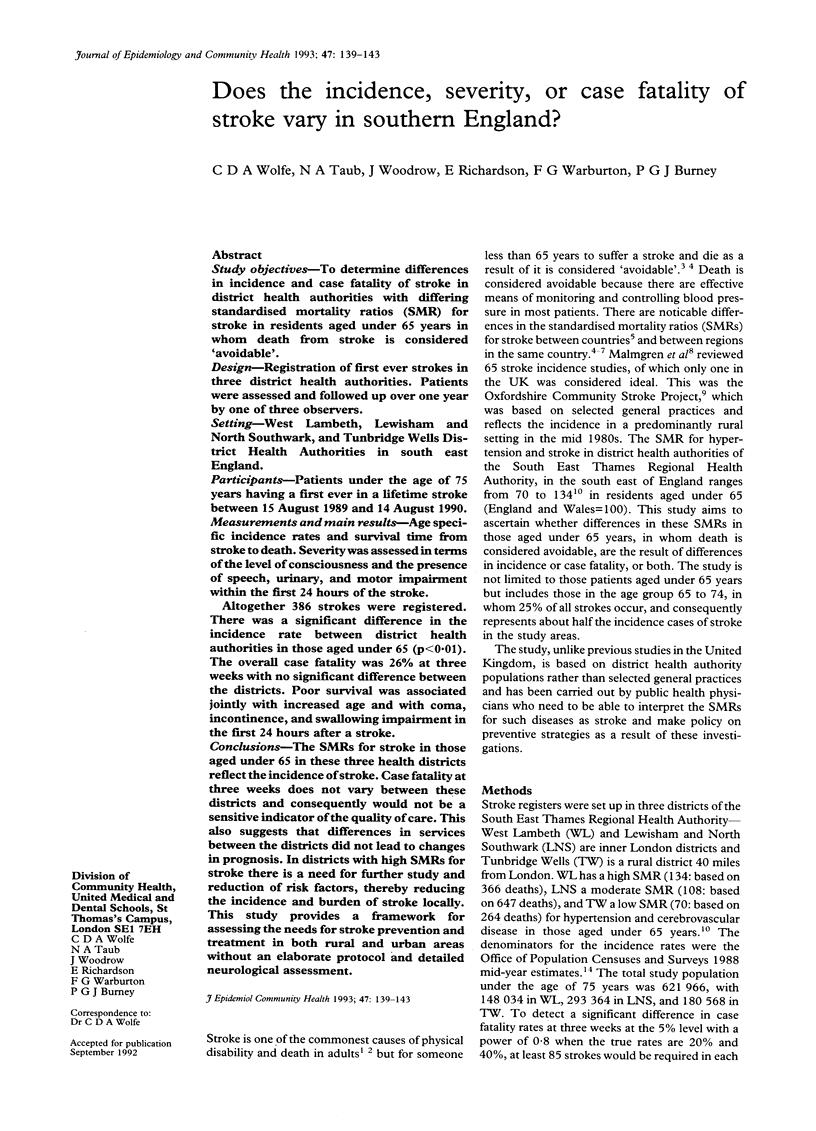
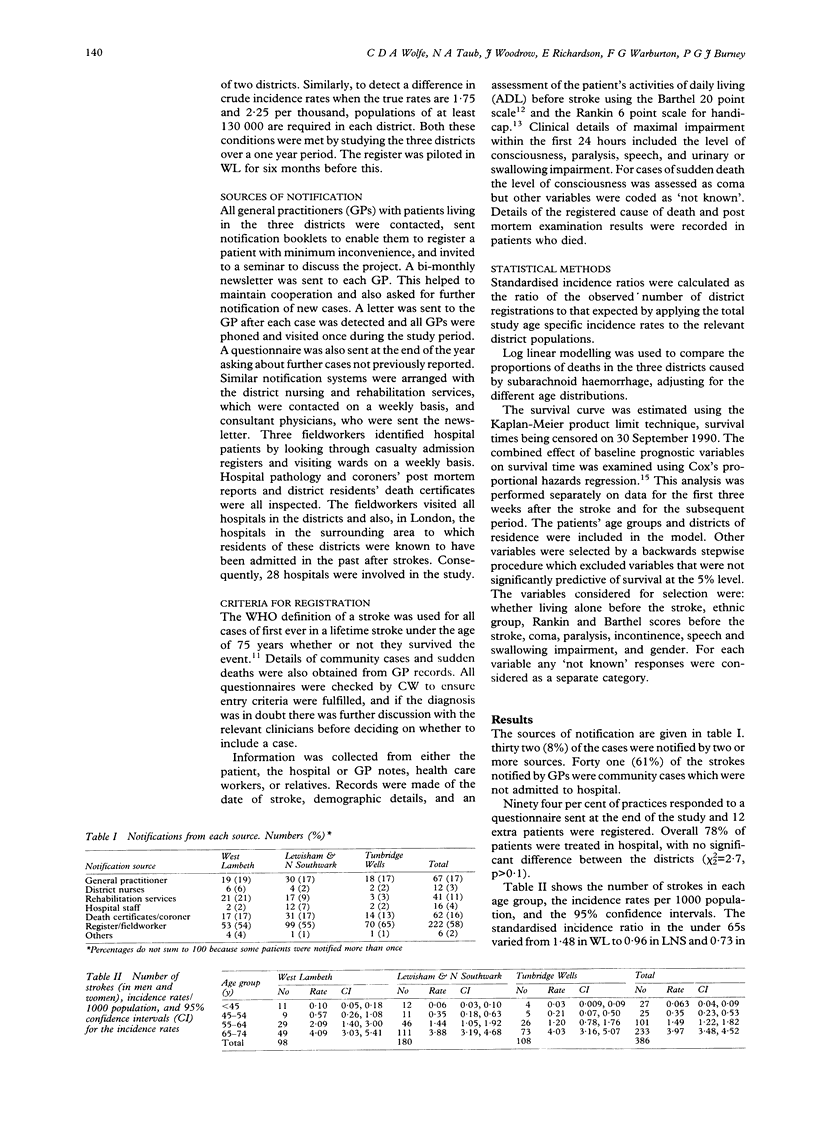
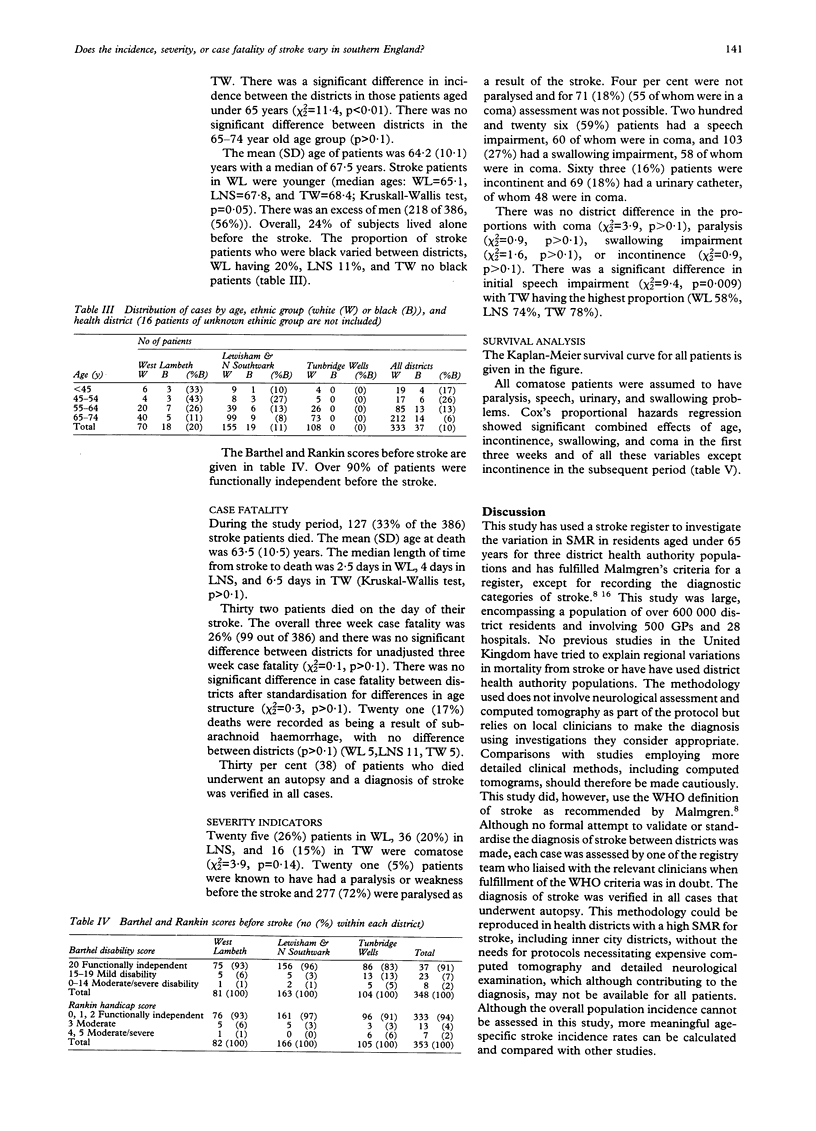
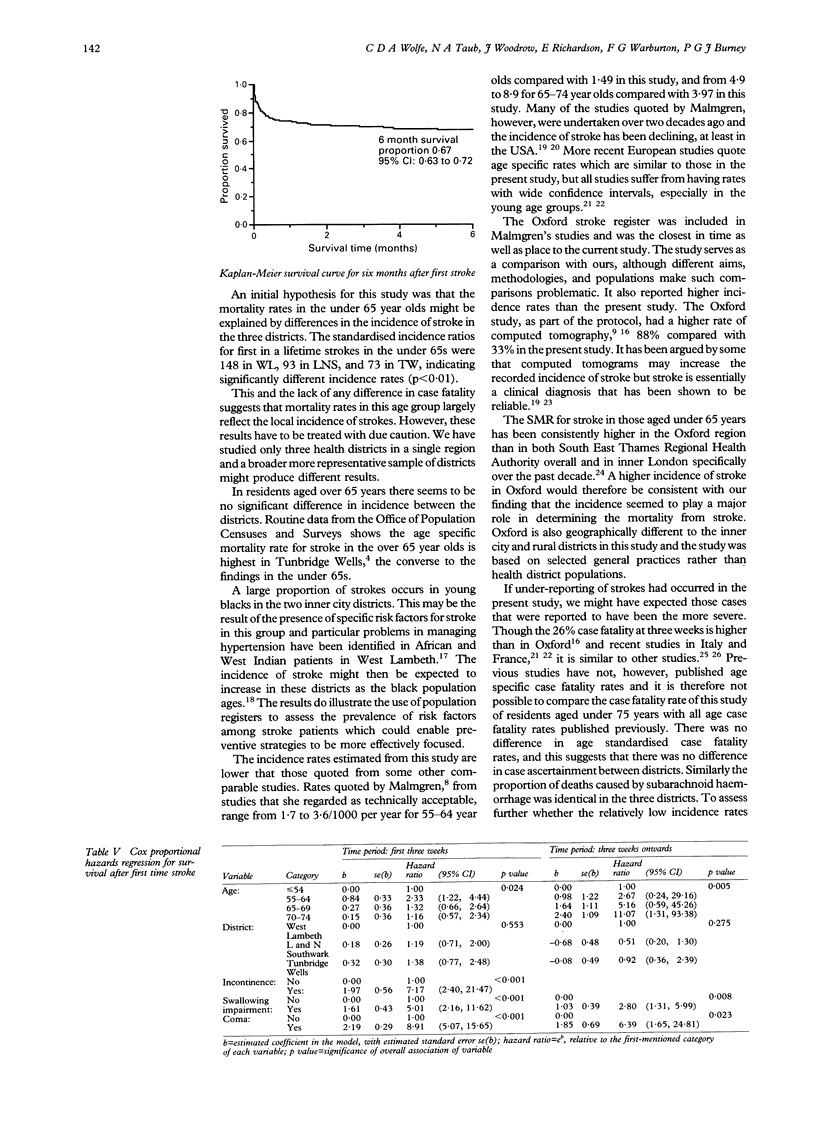
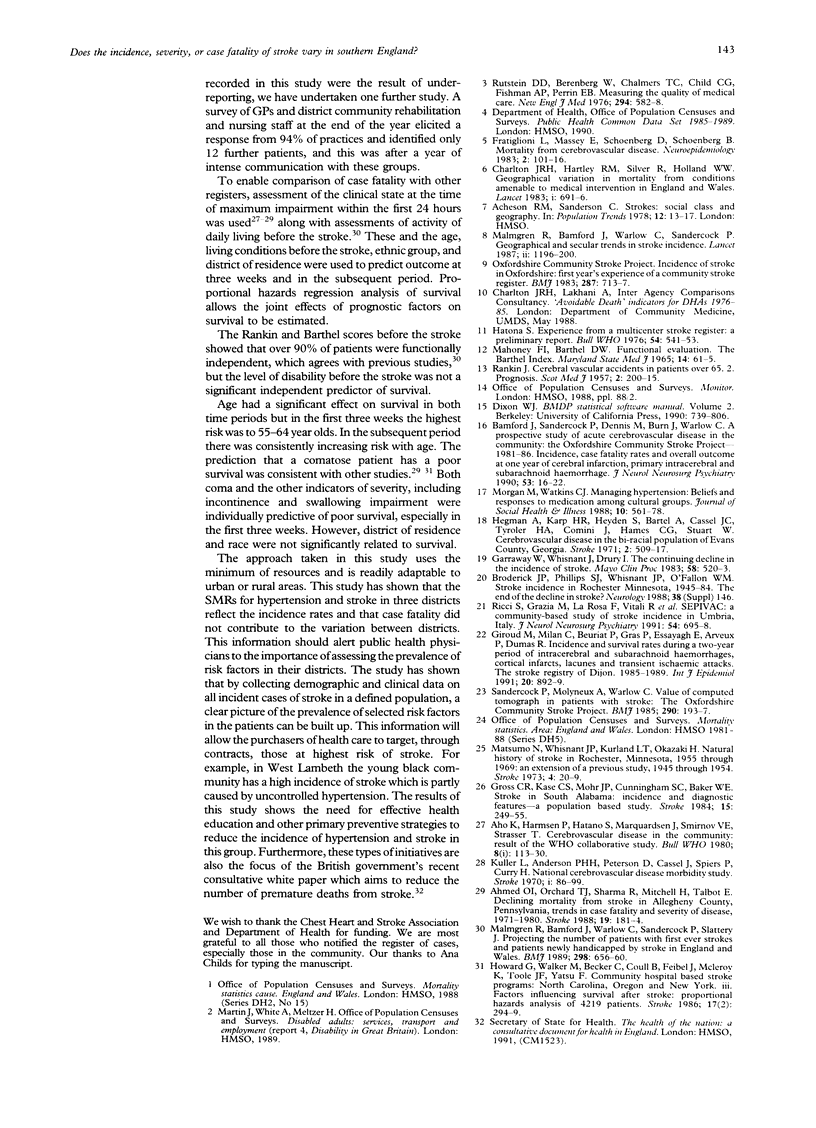
Selected References
These references are in PubMed. This may not be the complete list of references from this article.
- Ahmed O. I., Orchard T. J., Sharma R., Mitchell H., Talbot E. Declining mortality from stroke in Allegheny County, Pennsylvania. Trends in case fatality and severity of disease, 1971-1980. Stroke. 1988 Feb;19(2):181–184. doi: 10.1161/01.str.19.2.181. [DOI] [PubMed] [Google Scholar]
- Aho K., Harmsen P., Hatano S., Marquardsen J., Smirnov V. E., Strasser T. Cerebrovascular disease in the community: results of a WHO collaborative study. Bull World Health Organ. 1980;58(1):113–130. [PMC free article] [PubMed] [Google Scholar]
- Bamford J., Sandercock P., Dennis M., Burn J., Warlow C. A prospective study of acute cerebrovascular disease in the community: the Oxfordshire Community Stroke Project--1981-86. 2. Incidence, case fatality rates and overall outcome at one year of cerebral infarction, primary intracerebral and subarachnoid haemorrhage. J Neurol Neurosurg Psychiatry. 1990 Jan;53(1):16–22. doi: 10.1136/jnnp.53.1.16. [DOI] [PMC free article] [PubMed] [Google Scholar]
- Charlton J. R., Hartley R. M., Silver R., Holland W. W. Geographical variation in mortality from conditions amenable to medical intervention in England and Wales. Lancet. 1983 Mar 26;1(8326 Pt 1):691–696. doi: 10.1016/s0140-6736(83)91981-5. [DOI] [PubMed] [Google Scholar]
- Garraway W. M., Whisnant J. P., Drury I. The continuing decline in the incidence of stroke. Mayo Clin Proc. 1983 Aug;58(8):520–523. [PubMed] [Google Scholar]
- Giroud M., Milan C., Beuriat P., Gras P., Essayagh E., Arveux P., Dumas R. Incidence and survival rates during a two-year period of intracerebral and subarachnoid haemorrhages, cortical infarcts, lacunes and transient ischaemic attacks. The Stroke Registry of Dijon: 1985-1989. Int J Epidemiol. 1991 Dec;20(4):892–899. doi: 10.1093/ije/20.4.892. [DOI] [PubMed] [Google Scholar]
- Gross C. R., Kase C. S., Mohr J. P., Cunningham S. C., Baker W. E. Stroke in south Alabama: incidence and diagnostic features--a population based study. Stroke. 1984 Mar-Apr;15(2):249–255. doi: 10.1161/01.str.15.2.249. [DOI] [PubMed] [Google Scholar]
- Heyman A., Karp H. R., Heyden S., Bartel A., Cassel J. C., Tyroler H. A., Cornoni J., Hames C. G., Stuart W. Cerebrovascular disease in the bi-racial population of Evans County, Georgia. Stroke. 1971 Nov-Dec;2(6):509–518. doi: 10.1161/01.str.2.6.509. [DOI] [PubMed] [Google Scholar]
- Howard G., Walker M. D., Becker C., Coull B., Feibel J., McLeroy K., Toole J. F., Yatsu F. Community Hospital-based Stroke Programs: North Carolina, Oregon, and New York. III. Factors influencing survival after stroke: proportional hazards analysis of 4219 patients. Stroke. 1986 Mar-Apr;17(2):294–299. doi: 10.1161/01.str.17.2.294. [DOI] [PubMed] [Google Scholar]
- Kuller L., Anderson H., Peterson D., Cassel J., Spiers P., Curry H., Paegel B., Saslaw M., Winkelstein W., Jr, Lilienfeld A. Nationwide cerebrovascular disease morbidity study. Stroke. 1970 Mar-Apr;1(2):86–99. doi: 10.1161/01.str.1.2.86. [DOI] [PubMed] [Google Scholar]
- Malmgren R., Bamford J., Warlow C., Sandercock P., Slattery J. Projecting the number of patients with first ever strokes and patients newly handicapped by stroke in England and Wales. BMJ. 1989 Mar 11;298(6674):656–660. doi: 10.1136/bmj.298.6674.656. [DOI] [PMC free article] [PubMed] [Google Scholar]
- Malmgren R., Warlow C., Bamford J., Sandercock P. Geographical and secular trends in stroke incidence. Lancet. 1987 Nov 21;2(8569):1196–1200. doi: 10.1016/s0140-6736(87)91331-6. [DOI] [PubMed] [Google Scholar]
- RANKIN J. Cerebral vascular accidents in patients over the age of 60. II. Prognosis. Scott Med J. 1957 May;2(5):200–215. doi: 10.1177/003693305700200504. [DOI] [PubMed] [Google Scholar]
- Ricci S., Celani M. G., La Rosa F., Vitali R., Duca E., Ferraguzzi R., Paolotti M., Seppoloni D., Caputo N., Chiurulla C. SEPIVAC: a community-based study of stroke incidence in Umbria, Italy. J Neurol Neurosurg Psychiatry. 1991 Aug;54(8):695–698. doi: 10.1136/jnnp.54.8.695. [DOI] [PMC free article] [PubMed] [Google Scholar]
- Rutstein D. D., Berenberg W., Chalmers T. C., Child C. G., 3rd, Fishman A. P., Perrin E. B. Measuring the quality of medical care. A clinical method. N Engl J Med. 1976 Mar 11;294(11):582–588. doi: 10.1056/NEJM197603112941104. [DOI] [PubMed] [Google Scholar]
- Sandercock P., Molyneux A., Warlow C. Value of computed tomography in patients with stroke: Oxfordshire Community Stroke Project. Br Med J (Clin Res Ed) 1985 Jan 19;290(6463):193–197. doi: 10.1136/bmj.290.6463.193. [DOI] [PMC free article] [PubMed] [Google Scholar]


